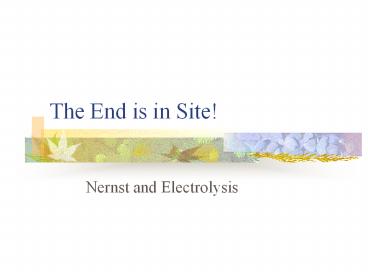The End is in Site! - PowerPoint PPT Presentation
1 / 24
Title:
The End is in Site!
Description:
The End is in Site! Nernst and Electrolysis Electrochemistry Galvanic (Electrochemical) Cells Spontaneous redox processes have: A positive cell potential, E0 A ... – PowerPoint PPT presentation
Number of Views:65
Avg rating:3.0/5.0
Title: The End is in Site!
1
The End is in Site!
- Nernst and Electrolysis
2
Electrochemistry
3
Galvanic (Electrochemical) Cells
- Spontaneous redox processes have
A positive cell potential, E0
A negative free energy change, (-?G)
4
Zn - Cu Galvanic Cell
From a table of reduction potentials
- Zn2 2e- ? Zn E -0.76V
- Cu2 2e- ? Cu E 0.34V
5
Zn - Cu Galvanic Cell
The less positive, or more negative reduction
potential becomes the oxidation
- Cu2 2e- ? Cu E 0.34V
Zn ? Zn2 2e- E 0.76V
Zn Cu2 ? Zn2 Cu E0 1.10 V
6
Line Notation
An abbreviated representation of an
electrochemical cell
Zn(s) Zn2(aq) Cu2(aq) Cu(s)
Anode material
Cathode material
Anode solution
Cathode solution
7
E0cell
E0cell RT/nF (lnK)
DG0 -nFE0cell
DG0
K
DG -RTlnK
8
Calculating ?G0 for a Cell
?G0 -nFE0
n moles of electrons in balanced redox equation
F Faraday constant 96,485 coulombs/mol e-
Zn Cu2 ? Zn2 Cu E0 1.10 V
9
The Nernst Equation
Standard potentials assume a concentration of 1
M. The Nernst equation allows us to calculate
potential when the two cells are not 1.0 M.
R 8.31 J/(mol?K)
T Temperature in K
n moles of electrons in balanced redox equation
F Faraday constant 96,485 coulombs/mol e-
10
Nernst Equation Simplified
At 25 ?C (298 K) the Nernst Equation is
simplified this way
11
Equilibrium Constants and Cell Potential
At equilibrium, forward and reverse reactions
occur at equal rates, therefore
- The battery is dead
- The cell potential, E, is zero volts
Modifying the Nernst Equation (at 25 ?C)
12
Calculating an Equilibrium Constant from a Cell
Potential
Zn Cu2 ? Zn2 Cu E0 1.10 V
13
Concentration Cell
???
Both sides have the same components but at
different concentrations.
Step 1 Determine which side undergoes oxidation,
and which side undergoes reduction.
14
Concentration Cell
???
Both sides have the same components but at
different concentrations.
Anode
Cathode
The 1.0 M Zn2 must decrease in concentration,
and the 0.10 M Zn2 must increase in concentration
Zn2 (1.0M) 2e- ? Zn (reduction)
Zn ? Zn2 (0.10M) 2e- (oxidation)
Zn2 (1.0M) ? Zn2 (0.10M)
15
Concentration Cell
???
Both sides have the same components but at
different concentrations.
Anode
Cathode
Spontaneous e- move from anode to cathode
(Voltage) Use Le Chatelier Increasing Zn2
(1.0M) forces the reverse to take
place Therefore, Decreasing the Ecell
16
Concentration Cell
Concentration Cell
???
Both sides have the same components but at
different concentrations.
Anode
Cathode
Step 2 Calculate cell potential using the Nernst
Equation (assuming 25 ?C).
Zn2 (1.0M) ? Zn2 (0.10M)
17
Nernst Calculations
Zn2 (1.0M) ? Zn2 (0.10M)
18
Electrolytic Processes
Electrolytic processes are NOT spontaneous. They
have
A negative cell potential, (-E0)
A positive free energy change, (?G)
19
Electrolysis of Water
In acidic solution
Anode rxn
-1.23 V
Cathode rxn
-0.83 V
-2.06 V
20
Electroplating of Silver
Anode reaction
Ag ? Ag e-
Cathode reaction
Ag e- ? Ag
Electroplating requirements
1. Solution of the plating metal
2. Anode made of the plating metal
3. Cathode with the object to be plated
4. Source of current
21
A couple of important relationships to
remember C coulomb charge transported by a
steady current of one ampere in one second C
amp x sec F C/n then C nF If you know
the moles of e- generated, then you use
stoichiometry to determine moles of the metal
that are deposited.
22
Example 1
Assume that 1.50amps of current flow through a
solution containing silver ions for 15.0 minutes.
The voltage is such that silver is deposited at
the cathode. How many grams of silver metal are
deposited? Ag e- Ag
Hint C amp x sec C 1.50 amp x (15min x
60sec/min) C 1.35 x 103 C Hint C nF
therefore n C/F n 1.35 x 103 C / 9.65 x 104
n 1.40 x 10-2 mole e- therefore 1.40 x
10-2 mole Ag 1.51g Ag are deposited
23
Example 2
- One ½ reaction occurring in the lead storage
battery is - Pb SO42- PbSO4 2e-
- If the battery delivers 1.50 amps and if its lead
electrode contains 454g of Pb, how long can
current flow? - Hint convert to mole Pb
- 454g 2.19mol Pb which means 4.38 mole e- are
produced - C nF 4.38 (9.65 x 104)
- C 4.23 x 105 C
- Hint C amp x sec
- 4.23 x 105 1.50amp x time
- Time 2.82 x 105sec 78.3 hours
24
(No Transcript)































